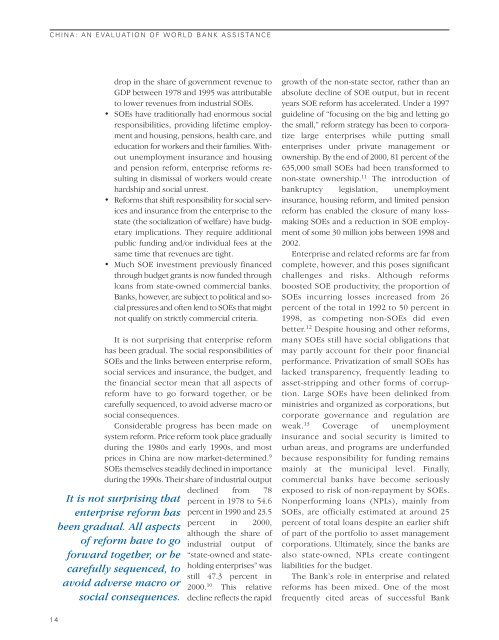Download Report - Independent Evaluation Group - World Bank
Download Report - Independent Evaluation Group - World Bank
Download Report - Independent Evaluation Group - World Bank
- No tags were found...
You also want an ePaper? Increase the reach of your titles
YUMPU automatically turns print PDFs into web optimized ePapers that Google loves.
CHINA: AN EVALUATION OF WORLD BANK ASSISTANCEdrop in the share of government revenue toGDP between 1978 and 1995 was attributableto lower revenues from industrial SOEs.• SOEs have traditionally had enormous socialresponsibilities, providing lifetime employmentand housing, pensions, health care, andeducation for workers and their families. Withoutunemployment insurance and housingand pension reform, enterprise reforms resultingin dismissal of workers would createhardship and social unrest.• Reforms that shift responsibility for social servicesand insurance from the enterprise to thestate (the socialization of welfare) have budgetaryimplications. They require additionalpublic funding and/or individual fees at thesame time that revenues are tight.• Much SOE investment previously financedthrough budget grants is now funded throughloans from state-owned commercial banks.<strong>Bank</strong>s, however, are subject to political and socialpressures and often lend to SOEs that mightnot qualify on strictly commercial criteria.It is not surprising that enterprise reformhas been gradual. The social responsibilities ofSOEs and the links between enterprise reform,social services and insurance, the budget, andthe financial sector mean that all aspects ofreform have to go forward together, or becarefully sequenced, to avoid adverse macro orsocial consequences.Considerable progress has been made onsystem reform. Price reform took place graduallyduring the 1980s and early 1990s, and mostprices in China are now market-determined. 9SOEs themselves steadily declined in importanceduring the 1990s. Their share of industrial outputIt is not surprising thatenterprise reform hasbeen gradual. All aspectsof reform have to goforward together, or becarefully sequenced, toavoid adverse macro orsocial consequences.declined from 78percent in 1978 to 54.6percent in 1990 and 23.5percent in 2000,although the share ofindustrial output of“state-owned and stateholdingenterprises” wasstill 47.3 percent in2000. 10 This relativedecline reflects the rapidgrowth of the non-state sector, rather than anabsolute decline of SOE output, but in recentyears SOE reform has accelerated. Under a 1997guideline of “focusing on the big and letting gothe small,” reform strategy has been to corporatizelarge enterprises while putting smallenterprises under private management orownership. By the end of 2000, 81 percent of the635,000 small SOEs had been transformed tonon-state ownership. 11 The introduction ofbankruptcy legislation, unemploymentinsurance, housing reform, and limited pensionreform has enabled the closure of many lossmakingSOEs and a reduction in SOE employmentof some 30 million jobs between 1998 and2002.Enterprise and related reforms are far fromcomplete, however, and this poses significantchallenges and risks. Although reformsboosted SOE productivity, the proportion ofSOEs incurring losses increased from 26percent of the total in 1992 to 50 percent in1998, as competing non-SOEs did evenbetter. 12 Despite housing and other reforms,many SOEs still have social obligations thatmay partly account for their poor financialperformance. Privatization of small SOEs haslacked transparency, frequently leading toasset-stripping and other forms of corruption.Large SOEs have been delinked fromministries and organized as corporations, butcorporate governance and regulation areweak. 13 Coverage of unemploymentinsurance and social security is limited tourban areas, and programs are underfundedbecause responsibility for funding remainsmainly at the municipal level. Finally,commercial banks have become seriouslyexposed to risk of non-repayment by SOEs.Nonperforming loans (NPLs), mainly fromSOEs, are officially estimated at around 25percent of total loans despite an earlier shiftof part of the portfolio to asset managementcorporations. Ultimately, since the banks arealso state-owned, NPLs create contingentliabilities for the budget.The <strong>Bank</strong>’s role in enterprise and relatedreforms has been mixed. One of the mostfrequently cited areas of successful <strong>Bank</strong>14
















